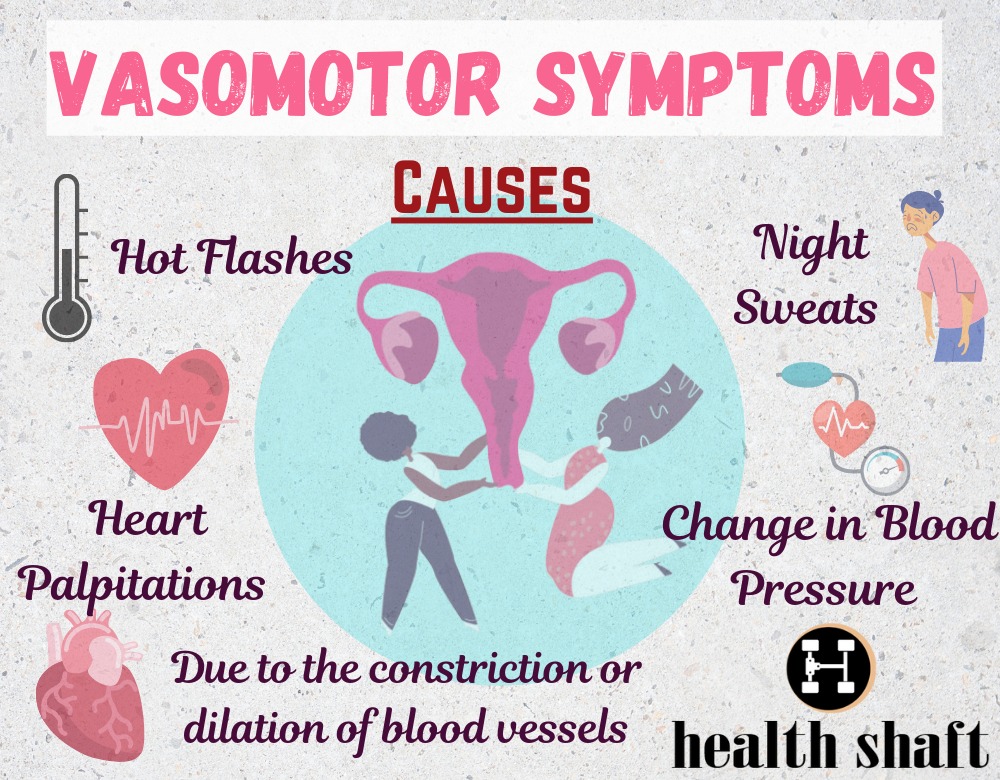Table of Contents
About vasomotor symptoms
The term “vasomotor” refers to activities that change the diameter of a blood vessel. Hot flashes and night sweats, often known as vasomotor symptoms (VMS), are commonly regarded as the cardinal symptoms of menopause. Hormonal variations impact the processes that govern blood pressure and temperature regulation, which is the most likely cause of these symptoms after menopause.
Vasomotor symptoms of menopause
The most common vasomotor symptom is hot flashes. A quick sense of heat affects the chest, neck, and face during a hot flash. Flushing, clamminess, anxiousness, and heart palpitations are common side effects of these feelings, which usually last 1 to 5 minutes. It’s possible that the skin in these locations will turn red.
Aside from perspiration, other vasomotor symptoms include sleep difficulties, anxiety, and heart palpitations.
The intensity of the symptoms varies, but they can be severe enough to impair psychological and overall well-being, interfering with routine everyday activities. These symptoms can continue anywhere from 5 to 7 years, but in up to 15% of women, they can last decades or even a lifetime.
Vasomotor Causes
Hot flashes are most likely caused by neurovascular alterations, which occur when the component of the nervous system that controls circulation changes.
Estrogen levels diminish throughout menopause, affecting your body’s capacity to regulate heat. Blood arteries near to the skin expand and increase blood flow, giving the sensation of a hot flash.
- Fragrances, scents, pollution, or secondhand smoking are all irritants in the environment.
- Weather variations, especially dry weather.
- Infections caused by viruses, such as the cold or flu, can be spread by eating or drinking hot or spicy foods.
- Certain sedatives, antidepressants, oral contraceptives, and pharmaceuticals to treat erectile dysfunction, such as aspirin (Bayer), ibuprofen (Advil, Motrin), or beta-blockers (propranolol, metoprolol, atenolol),
- Nasal decongestant sprays are being used excessively.
- Changes in hormones caused by pregnancy or menstruation.
- Hypothyroidism.
- Stress.
Vasomotor Risk factors
VMS are linked to an increased risk of diabetes, especially in women who have night sweats and other postmenopausal symptoms.
The menopausal transition may be an ideal time for doctors to talk to patients about long-term cardiovascular/metabolic risk and utilize the discomfort of present symptoms to motivate behavior change to improve VMS and lower diabetes risk.
Smoking and obesity are two factors that may raise the risk. Of vasomotor symptoms
Vasomotor symptoms treatment
Hormone therapy
Estrogen substitute the most effective treatment for VMS is hormone replacement therapy. Hormone treatment lowers the frequency and intensity of hot flashes by 75%–79%, according to the most current Cochrane analysis.
Hormone treatment seeks to bring the body’s hormone levels back into equilibrium. It can help with hot flashes and other symptoms, but it isn’t for everyone because it can have negative side effects. Although hormone therapy is successful in the treatment of VMS, findings from the Women’s Health Initiative (WHI) show that it may have deleterious consequences on breast tissue, since its usage has been linked to an increased risk of breast cancer.
Antidepressant drugs
Nonhormonal drugs such as selective serotonin reuptake inhibitors (SSRIs), serotonin-nor epinephrine reuptake inhibitors (SNRIs), clonidine (Catapres), and gabapentin (Neurontin) are useful for treating vasomotor symptoms, albeit paroxetine (Paxil) is the sole one. For menopausal symptoms, a doctor would normally prescribe a lesser dosage than for depression. Headaches, nausea, and sleepiness are all possible side effects.
Many women experience minimal symptoms during menopause and do not need to take any drugs. An individual should explore the advantages and disadvantages of taking drugs with their doctor.
Pregabalin, Gabapentin, and Clonidine are examples of nonhormone treatment.
nonpharmacologic: acupuncture, hypnosis.
There are a variety of nonpharmacologic therapies for VMS. Acupuncture, hypnotherapy, and lifestyle adjustments are just a few of the options. The evidence for these therapies as a whole is mixed.
Changes in your way of life
- Clothing that is layered
- The ambiance is cool.
- Iced beverages
- Avoiding spicy or hot foods
- Weight loss/exercise
- Quitting smoking
Pharmacologic
For the treatment of VMS associated with menopause, a range of herbal drugs and vitamin supplements have been explored, including black cohosh, dehydroepiandrosterone, evening primrose oil, phytoestrogens, and vitamin E.
People also ask
How do you treat vasomotor symptoms?
Systemic HT is the most effective treatment for vasomotor symptoms, while SSRIs, SNRIs, and clonidine have all been proven to be beneficial. Systemic or topical HT can be used to treat vaginal problems, although topical treatments are preferred since they have less side effects.
What causes vasomotor instability?
The most prevalent presenting symptom in postmenopausal women is vasomotor instability. Its specific aetiology is unknown; however it is thought to be mediated at the hypothalamic level. Estrogen regulates the amounts of neurotransmitters in the central nervous system, which helps in thermoregulation.
What are vasomotor changes?
Vasomotor symptoms are those that develop as a result of blood vessel constriction or dilation… Changes in skin temperature and color are signs of vasomotor disruption. A reduction in blood flow in CRPS patients with chilly extremities might result in reduced tissue saturation and acidity, resulting in ischemic discomfort.
How long can vasomotor symptoms last?
Vasomotor symptoms can last anywhere from one to five minutes and include sweat, flushing, chills, anxiety, and even heart palpitations. Menopause’s vasomotor symptoms can endure for more than two years, with a median of roughly four years.
Where the vasomotor is located?
The vasomotor centre is a group of integrating neurons in the middle brain stem’s medulla oblongata.
Does anxiety cause vasomotor symptoms?
Anxiety is often accompanied by a feeling of being hot or flushed. A person may have a quick sense of heat, comparable to a hot flash, when they are panicked or stressed. This occurs as a result of the body’s “fight, flight, freeze, or fawn” reaction, which is the body’s way of anticipating danger.
Conclusion
Menopause is characterized by vasomotor symptoms, particularly hot flashes. They don’t impact everyone the same way, and they have various effects on different people.
The menopausal transition may be an ideal time for doctors to talk to patients about long-term cardiovascular/metabolic risk and utilise the discomfort of present symptoms to motivate behaviour change to improve VMS and lower diabetes risk.
Anyone who feels that vasomotor symptoms are having a substantial impact on their daily life should consult a doctor, who may be able to offer therapies or lifestyle modifications that might assist.

